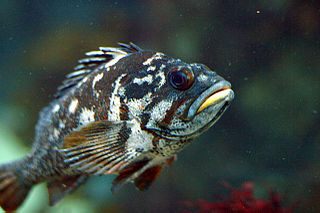
Sebastinae is a subfamily of marine fish belonging to the family Scorpaenidae in the order Scorpaeniformes. Their common names include rockfishes, rock perches, ocean perches, sea perches, thornyheads, scorpionfishes, sea ruffes and rockcods. Despite the latter name, they are not closely related to the cods in the genus Gadus, nor the rock cod, Lotella rhacina.
The Mastacembelidae are a family of fishes, known as the spiny eels. The Mastacembelids are part of the Order Synbranchiformes, the swamp eels, which are part of the Actinopterygii.
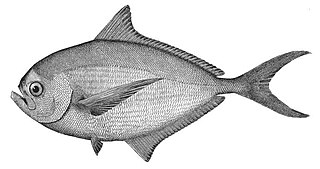
Pomfrets are scombriform fish belonging to the family Bramidae. The family currently includes 20 species across seven genera. Several species are important food sources for humans, especially Brama brama in South Asia. The earlier form of the pomfret's name was "pamflet", a word which probably ultimately comes from Portuguese pampo, referring to various fish such as the blue butterfish. The fish meat is white in color.
Notacanthidae, the deep-sea spiny eels, are a family of fishes found worldwide below 125 m (410 ft), and as deep as 3,500 m (11,500 ft).

Snipe eels are a family, Nemichthyidae, of eels that consists of nine species in three genera. They are pelagic fishes, found in every ocean, mostly at depths of 300–600 m (980–1,970 ft) but sometimes as deep as 4,000 m (13,000 ft). Depending on the species, adults may reach 1–2 m (39–79 in) in length, yet they weigh only 80–400 g (2.8–14.1 oz). They are distinguished by their very slender jaws that separate toward the tips as the upper jaw curves upward. The jaws appear similar to the beak of the bird called the snipe. Snipe eels are oviparous, and the juveniles, called Leptocephali, do not resemble the adults but have oval, leaf-shaped and transparent bodies. Different species of snipe eel have different shapes, sizes and colors. The similarly named bobtail snipe eel is actually in a different family and represented by two species, the black Cyema atrum and the bright red Neocyema erythrosoma.
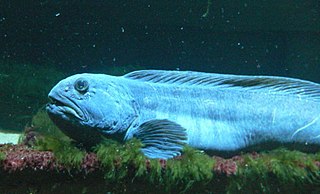
Anarhichadidae, the wolffishes, sea wolves or wolf eels, is a family of marine ray finned fishes belonging to the order Perciformes. These are predatory, eel shaped fishes which are native to the cold waters of the Arctic, North Pacific and North Atlantic Oceans.
Cyema is a monospecific genus of marine ray-finned fish belonging to the monotypic family Cyematidae. The only species in the genus is Cyema atrum, the arrow eel, bobtail eel, bobtail snipe eel or deepwater eel. This species has circumglobal distribution.

Monognathus, or onejaw, is the only genus of the family Monognathidae of deep-sea eels. The name comes from the Greek monos meaning “one” and gnathos meaning “jaw”, a reference to the large mouth in comparison with the rest of the fish, and also the absence of an upper jaw.
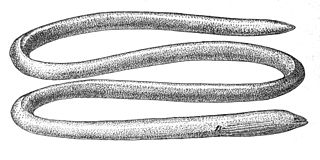
The Moringuidae are a small family of eels commonly known as spaghetti eels or worm eels, although the latter name is also shared with other families of eels.
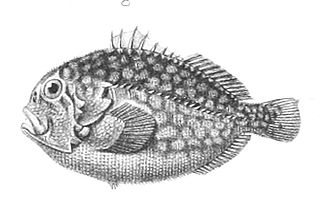
Caracanthus, the coral crouchers, or orbicular velvetfishes, are a genus of ray-finned fishes. They live in coral reefs of the tropical Indo-Pacific. This genus is the only member of the monotypic subfamily Caracanthinae, part of the family Scorpaenidae.

The Chlopsidae, or false morays, are a family of marine ray-finned fishes belonging to the order Anguilliformes, the eels. The eels in this family arefound in coral reefs worldwide. As their name suggests, they somewhat resemble moray eels in appearance. However, they are smaller than true morays, ranging from 11 to 42 cm in length.
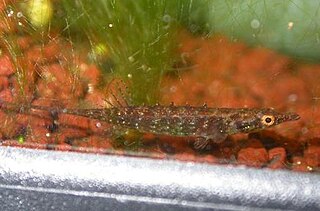
Indostomus is a genus of small fishes native to slow moving or stagnant freshwater habitats in Indochina. It is the sole genus of the monogeneric family Indostomidae, Long considered to be sticklebacks, within the order Gasterosteiformes, modern analyses place the Indostomids within the order Synbranchiformes, related to the spiny eels and swamp eels.
Notacanthus is a genus of spiny eels in the family Notacanthidae.
Lipogenys gillii, the blackfin tapirfish, is a species of spiny eel in the family Notacanthidae, the only member of its genus. It is a benthic deep-sea fish occurring along the eastern coast of North America and in the southwestern Pacific near Australia at depths from 400 to 2,000 m.
Polyacanthonotus is a genus of spiny eels, with these currently recognized species:

Brotula is a genus of cusk-eels. It is the only genus in the subfamily Brotulinae.
Brotulotaenia is a genus of cusk-eels. It is the only genus in the subfamily Brotulotaeniinae.

Synbranchinae is a subfamily of swamp eel, consisting of six of the ten genera in the family Synbranchidae. The remaining genus, the monotypic Macrotrema is the only one in the other subfamily Macrotreminae. The subfamily occurs in the Neotropics, Afrotropics and Asia.
Gymnelinae is a subfamily of marine ray-finned fish belonging to the family Zoarcidae, the eelpouts. Most species are found in the North Pacific Ocean but one genus is cosmopolitan, and another is endemic to the Southern Ocean.

Ilyophinae, the arrowtooth ells or mustard eels, is a subfamily of marine ray-finned fishes belongiing to the family Synaphobranchidae, the cutthroat eels. Within its family this subfamily shows greatest number of species and the greatest morphological diversity.












